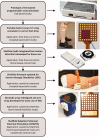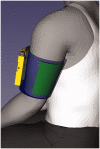Usability engineering in practice: developing an intervention for post-stroke therapy during a global pandemic
- PMID: 36001089
- PMCID: PMC9612925
- DOI: 10.1080/03091902.2022.2089257
Usability engineering in practice: developing an intervention for post-stroke therapy during a global pandemic
Abstract
This paper provides an overview of the usability engineering process and relevant standards informing the development of medical devices, together with adaptations to accommodate situations such as global pandemics where use of traditional face-to-face methods is restricted. To highlight some of those adaptations, a case study of a project developing a novel electronic rehabilitation device is referenced, which commenced in November 2020 amidst the COVID-19 pandemic. The Sheffield Adaptive Patterned Electrical Stimulation (SHAPES) project, led by Sheffield Teaching Hospitals NHS Foundation Trust (STH), aimed to design, manufacture and trial an intervention for use to treat upper arm spasticity after stroke. Presented is an outline and discussion of the challenges experienced in developing the SHAPES health technology intended for at-home use by stroke survivors and in implementing usability engineering approaches. Also highlighted, are the benefits that arose, which can offer easier involvement of vulnerable users and add flexibility in the ways that user feedback is sought. Challenges included: restricted travel; access to usual prototyping facilities; social distancing; infection prevention and control; availability of components; and changing work pressures and demands. Whereas benefits include: less travel; less time commitment; and greater scope for participants with restricted mobility to participate in the process. The paper advocates a more flexible approach to usability engineering and outlines the onward path for development and trialling of the SHAPES technology.
Keywords: SHAPES; Stroke; intervention; stroke therapy; usability engineering.
Conflict of interest statement
No potential conflict of interest was reported by the author(s).
Figures








References
-
- International Standards Organisation (ISO) . Ergonomics of human-system interaction — part 210: Human-centred design for interactive systems. ISO 9241-210:2019. [cited 2021 Nov 4]. Available from: https://www.iso.org/standard/77520.html
-
- Bias RG, Mayhew DJ.. Cost-justifying usability: an update for the internet age. San Francisco (CA): Morgan Kaufmann Publishers; 2005.
-
- Howard J, Fisher Z, Kemp AH, et al. . Exploring the barriers to using assistive technology for individuals with chronic conditions: a meta-synthesis review. Disabil Rehabil Assist Technol. 2022;17(4):390–319. - PubMed
MeSH terms
LinkOut - more resources
Full Text Sources
Medical
